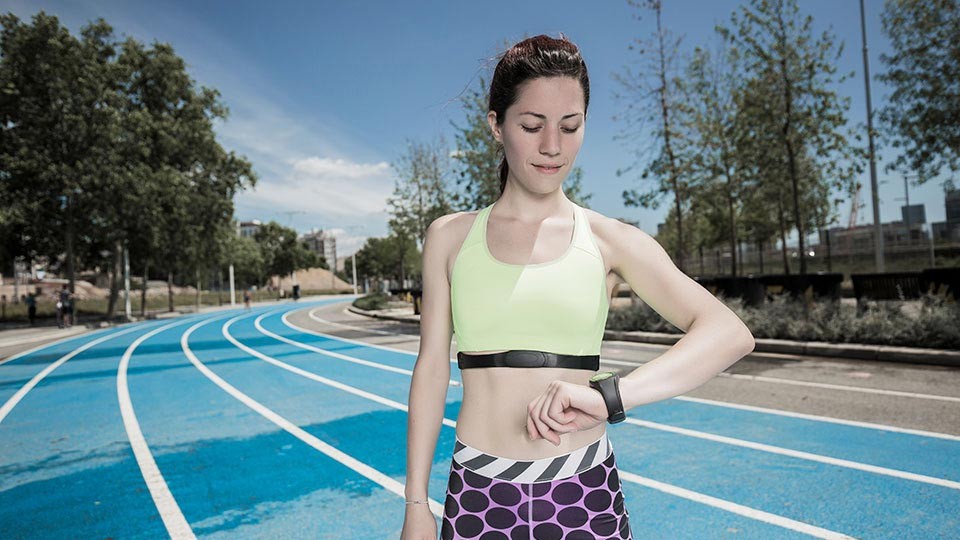RUN BETTER WITH OUR NEWSLETTER
Weekly updates on gear, offers & events
JOIN NOW
When the heart beats, an electrical signal is transmitted through the heart muscle in order for it to contract. The transmitter picks up this signal and sends it to the wrist receiver, which displays the data.
Heart Rate Monitors used to consist of a transmitter attached to a chest strap and a receiver in form of a watch. Nowadays there are models that have a built-in optical heart rate monitor, which means – as long as the watch fits correctly – there's no need to wear a chest strap. There are features that you won’t get from optical reading, but there is an option to use the chest strap monitor with these models too.
A heart rate monitor indicates your workout intensity, helping you train optimally by ensuring you neither overexert nor underexert yourself. By understanding your limits, you can set clearer goals, maintain focus, and achieve better results more efficiently while effectively burning calories and building muscle.
What is your goal? Do you want to improve your aerobic fitness, lose weight, are you coming back from a long break or do you have specific race goals in mind?
The advanced monitors have the capacity to calculate most of this data for you. For those of you who don't have these features, the following formulas will guide you.
There are four main heart rate zones:
It's incredible how quickly technology changes nowadays; All of the GPS running watches have a wrist-based heart rate monitor included. How do you choose the most suitable model?
A basic GPS watch with a heart rate monitor is a great option if you need to track pace, distance and time. As our top seller, all watches in our Garmin range have wrist-based heart rate features – which is very convenient. They have smart notifications – you'll be able to see the messages and phone calls on your watch screen. You are able to track your daily steps, distance and calories – and even your sleep! Not bad, right?
The more advanced the GPS watch, the more features you get, so consider your watch choice if you not only run, but also swim or cycle. As a casual runner, hiker and gym enthusiast I find the features on the Garmin Forerunner 265s to have exactly what I need. If you're someone seeking a watch that's more specialised that include profiles like obstacle running, diving and water sports (surfing, kiteboarding) then the Fenix 8 would be the best option. This military-grade, highly durable watch has a metal rear case, sapphire or gorilla glass screen. And also features a built-in flashlight.
Another amazing unparalleled watch from our range is the Garmin 970, specifically tailored for thriatlon and multisport athletes, offering extensive data tracking and comfort for long-term use. With lightweight titanium bezel, more durable sapphire glass, touch-screen AMOLED display and buttons, built-in full colour maps for navigation, and not to mention the exceptionally advanced training tools such as Running Economy, Training Load, Training Readiness, Recovery Insights, Garmin Coach and Running Dynamics.
Why would you need a strap if you have a heart rate measured from your wrist? Well, the heart-rate chest strap gives you more accurate running dynamics: cadence, stride length, vertical ratio, vertical oscillation, ground contact time and balance. It's very useful information if you are training for a race and you want to measure your running technique and performance more accurately!
How to Breathe While Running
How does breathing actually work? What is the diaphragm and what does it do? What are belly breathing & rhythmic breathing? How do they help you run?
VO2 Max and Lactate Testing for Runners
The higher your VO2 max is, the more oxygen your body can deliver to your muscles and the harder and faster you can train and run.
Best Running Head Torches: 2025
A running head torch is a great way to stay safer if you need to train in the dark. Check out the latest technology in this handy guide. Free UK delivery.
How to Drink While Running
What are the best ways to carry water while running, especially in hot weather or longer distances? Get expert tips on the latest bottles, belts and packs.
Leave a Comment
This site is protected by reCAPTCHA and the Google Privacy Policy and Terms of Service apply.